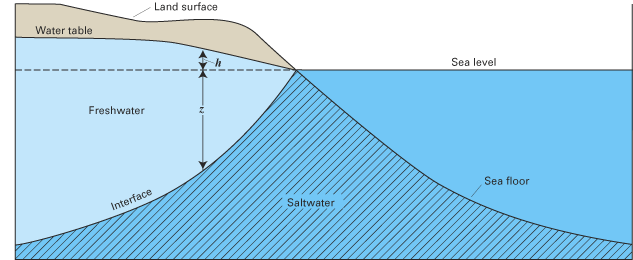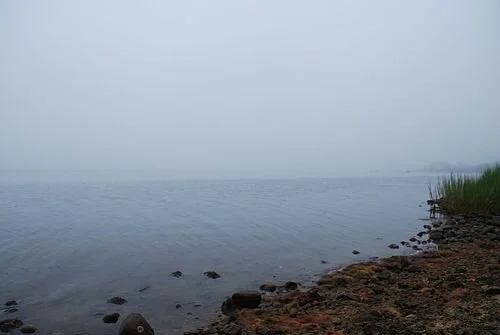Salt water is contaminating wells in Rhode Island as sea level rises
From ecoRI News
Drinking water wells at homes along the Rhode Island coastline are being contaminated by an intrusion of salt water, and as sea levels rise and storm surge increases as a result of the changing climate, many more wells are likely to be at risk.
To address this situation, a team of University of Rhode Island researchers is conducting a series of geophysical tests to determine the extent of the problem.
“Salt water cannot be used for crop irrigation, it can’t be consumed by people, so this is a serious problem for people in communities that depend on freshwater groundwater,” said Soni Pradhanang, associate professor in the URI Department of Geosciences and the leader of the project. “We know there are many wells in close proximity to the coast that have saline water, and many others are vulnerable. Our goal is to document how far inland the salt water may travel and how long it stays saline.”
Salt water can find its way into well water in several ways, according to Pradhanang. It can flow into the well from above after running along the surface of the land, for instance, or it could be pushed into the aquifer from below. Sometimes it recedes on its own at the conclusion of a storm, while other times it remains a permanent problem.
Pradhanang and graduate student Jeeban Panthi are focusing their efforts along the edge of the salt ponds in Charlestown and South Kingstown, where the problem appears to be the most severe.
Since salt water is denser than fresh water, it typically settles below. So the scientists are using ground-penetrating radar and electrical resistivity tests — equipment loaned from the U.S. Geological Survey and U.S. Department of Agriculture — to map the depth of the saltwater/freshwater interface.
“In coastal areas, there is always salt water beneath the fresh water in the aquifer, but the question is, how deep is the freshwater lens sitting on top of the salt water,” said Panthi, who also collaborates with URI professor Thomas Boving. “We want to know the dynamics of that interface.”
The URI researchers plan to drill two deep wells this month to study the geology of the area and the chemistry of the groundwater to verify the data collected in their geophysical tests.
The first tests were conducted in the summer of 2019, and a second series was completed this fall after being delayed by the pandemic. Final tests will be conducted this spring when groundwater levels should be at their peak.
“The groundwater level was at its lowest point in 10 years this summer because of the drought,” said Panthi, a native of Nepal who studied mountain hydrology before coming to URI. “That will be a good comparison against what we expect will be high levels in April and May.”
Panthi has collected well-water samples from nearly two dozen residences for analysis. One of the contaminated wells is a mile inland from Ninigret Pond, in Charlestown.
Ninigret Pond, in Charlestown, R.I.
“A homeowner had a deep well drilled for a new house and it ended up with extremely saline water,” Pradhanang said. “Deep wells close to the salt ponds or the coast are more likely to have saltwater intrusion than shallow wells, though shallow wells can also have problems if they become inundated with salt water.”
Another URI graduate student, Mamoon Ismail, is developing a model to simulate saltwater intrusion into drinking water wells based on the changing pattern of precipitation and the potential for extreme storms. They hope to be able to predict how far inland salt water will intrude following a Category 1 hurricane compared to a Category 2 storm, for instance.
This research is being funded by the Rhode Island office of the U.S. Department of Housing and Urban Development.
The role of grasshoppers in salt-marsh ecosystems
Salt marsh along the Connecticut shore of Long Island Sound.
American grasshopper.
From ecoRI News (ecori.org)
KINGSTON, R.I.
As efforts are being undertaken to protect salt marshes — and the threatened salt marsh sparrow — from the rising sea, scientists may be ignoring an unexpectedly important player in this environmental drama: grasshoppers.
According to Becky Gumbrewicz, a University of Rhode Island senior who studied insects at three salt marshes in the Ocean State this summer, grasshoppers and their close relatives constitute the greatest insect biomass per individual on salt marshes in the region, and they are probably an important food source for the sparrows. But as dredged sand and mud are deposited on some marshes to raise their elevation to combat sea-level rise, grasshoppers may get lost in the mix.
“We’re curious about how adding that layer of dredged material to the marsh is going to affect the insect populations, like the grasshoppers, that could possibly be buried,” said Gumbrewicz, a resident of Oxford, Conn., who is majoring in environmental science and management. “We’re trying to get an idea of how to balance combating sea-level rise to preserve the salt marshes and benefit the sparrow but also figure out how the insects are impacted and may need to be supported.”
Working in collaboration with URI Prof. Steven Alm and the Rhode Island Natural History Survey, Gumbrewicz collected insects at three salt marshes: one inland undisturbed site on the Narrow River; one undisturbed coastal marsh on Ninigret Pond, and a disturbed site on Ninigret Pond that is undergoing restoration by adding a layer of dredged material to raise its elevation. Among the mass of flies, crickets, spiders, moths, and beetles she collected were large numbers of grasshoppers.
“We found most of the grasshoppers near the upland woody vegetation, which is where we think they might be laying their eggs,” Gumbrewicz said. “So if we were to suggest a way to improve salt marsh restoration efforts, it would be to plant more woody vegetation.”
In addition to her field studies, she also kept grasshoppers in a cage with marsh grasses and other upland vegetation to see where the insects lay their eggs.
“We’re still going over our data and finalizing our numbers, but hopefully with what we’ve collected so far we can make a strong suggestion for further research to be done and possibly revise some of the strategies used in marsh restoration,” she said.
Gumbrewicz’s research was funded by the Rhode Island Coastal Resources Management Council through a contract with the Natural History Survey. It was also supported by the URI Coastal Fellows program, an initiative designed to involve undergraduate students in addressing current environmental problems. Now in its 22nd year, it’s based at URI’s College of the Environment and Life Sciences. Students are paired with a mentor and research staff to help them gain skills relevant to their academic major and future occupations.
“There hasn’t been a lot of research about how raising salt marshes affects insects; it’s usually been about plants or larger organisms,” Gumbrewicz said. “So the project has opened my mind to lots of new ideas.”







